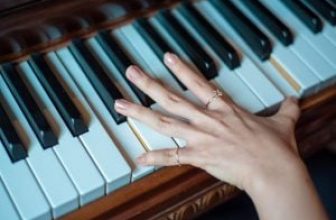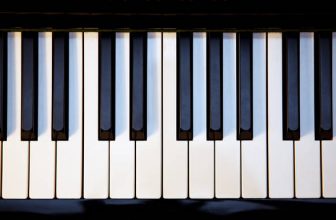
Introduction
Beginners often ask, “What’s easier to learn piano or guitar?” Each instrument has it’s positive and negative aspects. An acoustic guitar has only six strings while a piano has 88 keys, (and in case you want to know, 220 strings). So if you’re looking at the size of the instrument, it might seem that the guitar would be easier to learn.
Piano vs Guitar – Main Differences
Piano Basics
Certain elements of the piano are easier than the guitar. You can think of the piano as a kind of “typewriter” – you hit a note and it plays the same exact note each time. But you also have to operate pedals.
Guitar Basics
The guitar, on the other hand, has “frets” to guide your fingers to find the notes. You can’t really see them well when you’re in the correct position holding a guitar, so a lot of it is by feel. Once you find the correct note, it’s very easy for that note to be out of tune so you have to quickly decide if you are flat or sharp and make tiny modifications with your finger. So from that point of view, the piano is easier.
Some Facts about Guitar and Piano
When a guitarist decides to learn piano or a pianist decides to learn the guitar, he or she will find some similarities between the two instruments. The most important similarity is that they use the same music notes and theory structure common across all instruments.
How the Notes are Laid Out
Each string of the guitar can play 12 different notes whereas each key on a piano only produces one specific note. So, the six strings of the guitar are like six miniature pianos. This is one reason why a beginner should probably learn the piano first as the notes are laid out clearer and more logically on the piano.
The first thing you have to do when you pick up a guitar is see if it’s in tune. If not, you need to tune it. When you sit down at a piano and play there’s nothing you can do about the tuning (unless of course you’re a piano tuner!)
Playing Differences
The main and obvious difference is that the guitar is a string instrument while the piano is considered a percussion instrument because the strings are struck by a hammer rather than plucked by the player. A guitar can be strummed or fingerpicked while the pianist has no contact with the strings. Here are some other differences on playing the two most popular instruments:
- Fingering
The finger numbers are different for these two musical instruments. For example, on the guitar, the first finger is considered the index finger. While finger “1” on the piano is the thumb. So, if a guitarist later learns piano, then his instinct will be to put his index finger on the keyboard to follow the finger numbers for piano music. The opposite may happen when a pianist learns guitar. However, it’s worth noting that this is true for many instruments and hundreds of people successfully play two or more instruments without any problem. Many people play both guitar and piano.
- Using both hands:
On the piano, you have to use both hands to play. If you learn the guitar first, then the piano will seem comparatively difficult. On the guitar, one hand manipulates the strings while the other hand does the strumming or picking. This is another skill and one that also needs practice and coordination.
- Playing a single note:
If you play a scale on the piano, you just play one note after the next like climbing a ladder, dropping one finger down at a time. Each key is just one particular note and it’s easy.
On the guitar, you also go up a ladder, but on the same string, so you play 12 different notes per string. You have to press the string down very firmly to get a clear note and this can hurt your fingertips when you first start practicing. Unlike the piano, there are several positions on the guitar where you can play the same exact note. This makes the guitar the more complex, making the piano a better contender as a starter instrument.
- Limitations in playing notes:
Using the piano pedal, you can play a fairly unlimited number of notes at one time. But on the guitar the most you can play is six notes. This makes the guitar somewhat limited in sound compared to the piano.
Visual differences
Sitting in front of the piano you can see the entire keyboard spread out in front of you and learn geographically where everything is. The black notes are grouped in twos and threes, giving you a visual reference for the white notes. You can also learn the layout of the piano by feel because of the pattern of the black notes.
On the guitar, it can be a bit overwhelming to learn all the notes on all the strings. For many chords played on the guitar the notes are far away from each other, needing a tricky and sometimes uncomfortable hand position.
The full harmonization of a song
As you now know, on the guitar you can play a maximum of six notes at a time so you can only get six-note harmony. This is why so many people sing while playing the guitar to accompany themselves. On the other hand, the piano can create far deeper and richer harmonies even while you play the tune in the highest range. However, to learn all the complex harmonies and tune of a song on piano takes much longer than strumming chords on a guitar and singing along.
On the piano, you can use guitar “tabs” (chord symbols” to play chords. If you don’t read music, this is a great option. It can make learning a song far quicker and easier this way. But you have to know your piano chords first. This isn’t hard to learn and in fact consists of much more logical patterns than chords on a guitar.
You can use a “fake book” full of famous songs with just the tune and the guitar tabs for either the piano or the guitar and very quickly work up a repertoire of songs you can play and sing.
Different Techniques of Playing
It has to be said that the guitar has a lot of different techniques needed to play well. Some of the techniques include bending, fingerpicking, vibrating and strumming. With these techniques you can create different sonic vibes, textures and rhythms. On the piano, there are also many different techniques such as playing staccato or legato. Also, loud or soft, glissando or big chords on the same beat.
Style of Music
Songwriters vs Classical
You only have to look at Alicia Keys, Emeli Sande, Billy Joel and Elton John to know that playing the piano can be really cool and a hugely successful form of musical communication within the pop/rock world. But there is another side of piano: classical music. This can also be very cool and impressive and takes much longer to master. It might take an average of ten years of study and intensive practice to be able to perform some master works on the piano.
Rock and Pop vs Classical
The guitar is far more associated with rock and pop. From Elvis Presley to Brian May, a guitarist is surely the coolest thing to be. But like the piano, there is another side to the guitar: classical music. If you’ve never heard “Concierto de Aranjuez” by Rodrigo, check it out. From music by J. S. Bach that he originally wrote for lute, such as “Bourrée in E minor”,
to “Cavatina” by Stanley Myers there is a rich library of classical music to be played on the guitar. And don’t forget the sultry Brazilian harmonies and rhythms of Heitor Villa-Lobos and Spanish music such as “Recuerdos de la Alhambra” by Tárrega.
Before you decide which instrument you want to learn check out some of the music for each instrument and see which moves you and makes you feel you want to learn to play.
Portability
Carry your Guitar
You can take your guitar with you anywhere. You can play your guitar when you hang out with your friends or go to the beach. This can make you popular (if you play well!) On the other hand, the piano is not as portable as a guitar. Even if you have a “portable” piano, you’ll find it difficult to set it up on a beach or play on a plane. The piano is usually static and therefore limits performance opportunities.
Hunt Down a Piano
Opportunities do arise to play the piano casually, of course. Many stations have old pianos available to play in public. Some hotels and restaurants have pianos that you might be able to play, but ask first.
When considering whether piano is easier than guitar, it’s good to keep in mind how easy it is to find a guitar in somebody’s house or keep one by your bed or next to your sofa. All you need to do is stretch your arm out and the instrument is in your hands ready to go. This might be one reason why many more people play the guitar than the piano.
Busking
With a Guitar
We all see loads of buskers with guitars and maybe a microphone. They’re in the subway stations, in the town centers and cities singing and playing and collecting change. It’s easy to take your kit on your back and set up to play for a few hours (sometimes you have to get a license though – so check if you plan to do this!)
With a Piano
You do see buskers with a portable piano in the street or subway, but it’s hardly ever as successful as a guitar busker. The pianos tend to be inferior (who would want to take their state-of-the-art digital piano onto the street?) and it just doesn’t have the same impact on the passers-by. However, it can be done, and it could certainly be done as part of a small band, guitar, bass and keyboards.
Cost
Cost of a Guitar
It’s easy to buy an inexpensive guitar. People often have more than one and lend or give one away. Of course if you buy a brand new Les Gibson guitar, you could splash out $10,000 or more. But on average you can get a really good new guitar for under $1000.
Cost of a Piano
Pianos can be found for free – but you get what you pay for. A good piano can cost anything from $1000 to $50,000. Choosing a piano is more difficult that choosing a guitar as once you have made a purchase, you have it for a very long time. Guitars tend to be more transient.
Finally…
Both the guitar and the piano have their important place in the world. So if you’ve been asking yourself, “Should I learn piano or guitar?” these points will help you to decide. When you start to learn one or the other, you’ll soon know whether you’ve chosen the right instrument to learn.
Whichever instrument you choose, do learn music theory as this can help you to learn much faster – and help you to transition from one to the other, too. If you understand key signatures, time signatures and chords, they will apply to both instruments equally.
Remember that learning an instrument takes time, dedication and tenacity. Give whichever instrument you decide on a really good try and enjoy the journey!






